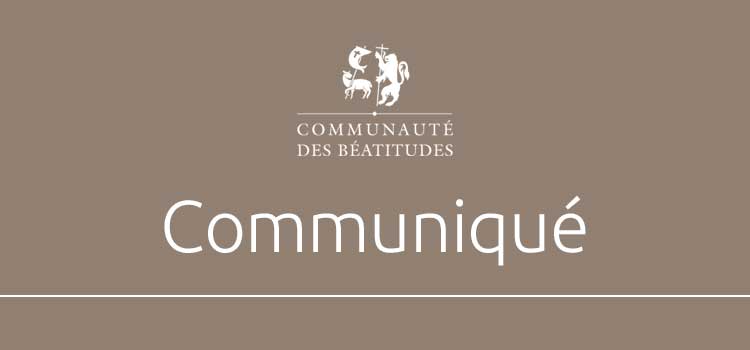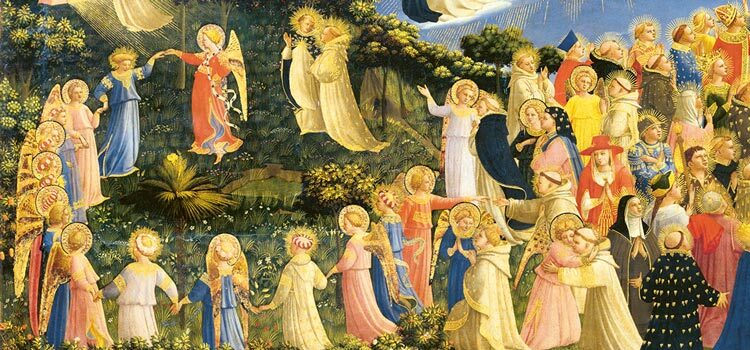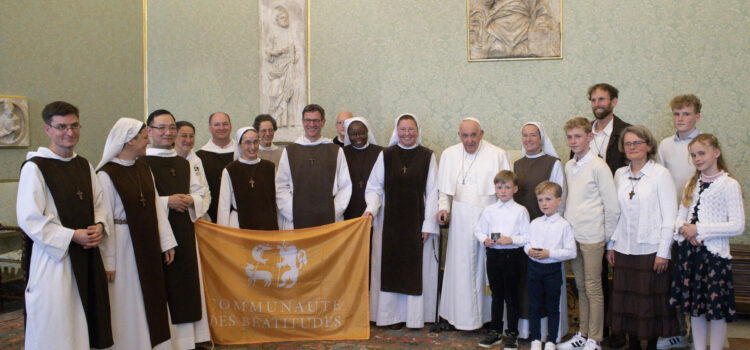Looking too quickly at the two realities of orison and liturgy, could lead us to oppose them : orison is more a personal prayer – private – that privileges silence, and liturgy is a community prayer – public prayer of the Church – lived according to a ritual made of gestures, words and singing. Yet orison and liturgy complement, serve and call each other.
Dialogal dimension
Orison and liturgy share the same dynamism and the same purpose : relationship and union with God. Indeed, « orison is nothing more than an intimate and friendly intercourse in which often converse alone with God, whom we know loves us. » (Ste Therese of Avila, Life 8). Whereas, the liturgy « is an encounter of God’s children with their Father, in Christ and the Holy Spirit, and this encounter is expressed as a dialogue through actions and words ». (CEC, n° 1153). In orison as in the liturgy, therefore, we find the dialogical dimension, which is none other than that of Revelation (cf. Dei Verbum, n°2). This dimension, obvious in the one-onone and heart-to-heart conversation of orison, is also made visible in the liturgy through acclamations, song and prayer.
The voice of the faithful is the privileged instrument of the believing heart that responds to God, like the bride to the bridegroom, like the child to its Father : « To this word received, the voice of the faithful responds in a liturgy essentially dialogical, where the words of the celebrant and the response of the faithful alternate, the Word of God and the receptive listening of the Church »as the future pope Benedict XVI writes in his book « The spirit of the liturgy ». He also reminds us in this reference work that silence in the liturgy is necessary for this dialogue between God and man. “To the God who speaks to us, we respond with song or prayer. But the great mystery that surpasses all words calls us to silence” (p. 164). Like orison, in the liturgy, “silence […] favors a truly profound, personal participation, allowing us to listen inwardly to the word of the Lord” (Conversations on Faith, p. 151). This is why, where the ritual proposes it, the challenge is to « make silence substantial ». This silence is not identified, with the « absence of speech or action » nor with « a pause in which a thousand thoughts and desiresd assail us » or with a « simple intermissioin in the liturgic action » (The spirit of liturgy, p.164). This liturgical silence is similar to the silence of orison. It is made of recollection, inner peace, attention to the essential, inner dialogue with the Lord.
Liturgy : source and end of all prayer
The liturgy, as a participation in Christ’s prayer, addressed to the Father in the Holy Spirit, and, as the celebration of the Mystery of Christ, is the source and end of all prayer (cf.CEC n° 1073 and 2655) This is what makes it a Christian prayer – Christ in all his mysteries is the center and leads us to the Father. The same Christocentrism is found in the Carmelite orison, which is so attentive to Christ’s holy humanity as a path to transforming union with the thrice Holy God.
More concretely, the different components of the liturgy, inspired by or drawn from the Word of God (readings, psalms, prayers, hymns, etc.) « reveal (…) the meaning of the Mystery celebrated, help in the understanding of the psalms and prepare for the silent orison » (CE, n°1177).
Similarly, « lectio divina, in which the Word of God is read and meditated upon in order to become prayer, is thus rooted in the liturgical celebration. »(CEC n° 1177)
Living the liturgy with the heart
Reciprocally, the quality of our life of orison, of our inner prayer, has an influence on our experience of the liturgy. It favors in fact, the harmony, the agreement between the external dimension of the rite (the proclamation of the Word, the vocal prayers, the singing, the gestures, etc.) and our deepest heart.
« Celebrating the Liturgy of the Hours requires (…) the voice be attuned with the praying heart » (CEC, n° 1176) and orison has at the service of this requierement.
Orison is therefore at the service of a liturgy that is worship in spirit and in, truth, the place of encounter, of union with God and of the sanctification of man. The Catechism of the Catholic Church affirms that « prayer internalizes and assimilates the Liturgy during and after its celebration » (CEC n° 2655)
Therefore, orison, recollection and attention to the Lord’s presence, before, during and after the liturgical celebration allow it to bear its full fruit of grace in our lives.
To pray unceasingly
Just as time spent in orison gradually imbues the whole of life with a spirit of prayer, time spent at the Eucharist and in the devine offices gradually transforms the whole of life into a liturgy.
Dom André Louf affirms that « every authentic liturgy tends to spread, to extend itself throughout the day to invade all available spaces, in time, in places, and especially in the hearts of those who pray. An authentic liturgy always bears fruit beyond itself. It rubs off on life, it tends to transform the latter entirely into an incessant liturgy.
What is said here of the liturgy can be understood as well of orison since an authentic orison always bears fruit beyond itself. It influences life, it tends to transform all of it in a never ceasing orison.
Moreover, as stated in the Sacrosanctum Concilium, the Second Vatican Council’s constitution on the Sacred Liturgy « The Divine Office, as the public prayer of the Church, is the source of piety and the nourishment of personal prayer » (n°90).
So we can see that orison and liturgy are intrinsically linked and mutually nourishing.
Let us give thanks to God for the beauty of our calling.
Quote
« Stop your work immediately when the bell rings for the devine office. The ringing of the bell gives you an opportunity to detach yourself from what you are doing. Go to the choir without delay, but peacefully. On the way, lift up your heart to God and rejoice that He has called you to sing his glory. »
Wilfrid Stinissen
Apophtegme of XX century
“Here, in some ancient cathedral […], is a venerable chapter of canons busy reciting the office. Suddenly a violent storm breaks out. Lightning and thunder follow one another and get closer. A shudder ran through the stalls, and the dean of the chapter, greatly moved, waved his hand and called out to his confreres: « Let us stop the office, my brothers, to pray for a moment. »
This apophthegm is reported to us by Dom André Louf to introduce his book on the liturgy as a path to prayer… because at the time, he writes, “there were not only canons who perceived with some difficulty the link between liturgy and prayer.” Let us pray that it will not be so in our midst !
(André LOUF, L’œuvre de Dieu, un chemin de prière, Paris, Lethielleux, 2005, p. 7-8).
To go further…Only for today
Livres :
|
Find the previous articles in our “Life of prayer” series.
(publication edited by brothers and sisters of the Community of the Beatitudes – © rights reserved).





